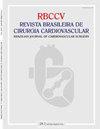预测多支冠状动脉疾病患者颈动脉狭窄的语法评分I和II:倾向评分匹配分析
IF 1.2
4区 医学
Q4 CARDIAC & CARDIOVASCULAR SYSTEMS
Revista Brasileira De Cirurgia Cardiovascular
Pub Date : 2019-12-01
DOI:10.21470/1678-9741-2019-0067
引用次数: 3
摘要
目的评价SYNTAX评分(SS) I和II对多支冠状动脉病变行冠状动脉搭桥术(CABG)患者颈动脉明显狭窄(CAS)的预测准确性。方法研究人群为416例。回顾性回顾临床、人口统计学和放射学记录。比较倾向评分匹配分析前后CAS患者(n=66)和非CAS患者(n=350)的特征。结果与无显著CAS的患者相比,显著CAS患者年龄较大[60(53-65)比63 (59-67);P = 0.01)。然而,两组之间的动脉粥样硬化危险因素和SS I相似。在CAS患者中,SS II CABG和经皮冠状动脉介入治疗(PCI)的评分明显更高[37.4(30.9-43.5)比33.8 (29.9-38.9);P = 0.02)。经倾向评分匹配分析(66比66),有CAS患者的年龄、SS II PCI和CABG明显高于无CAS患者[37.4(30.9-43.5)比33 (29.3-36.9);P = 0.03)。logistic回归分析显示,年龄、SS II PCI和CABG与CAS相关[OR=1.086, 95% CI (1.032-1.143), P33.1预测CAS的敏感性为68.2%,特异性为54.6% [AUC=0.624, P=0.01, 95% CI(0.536-0.707)],而SS II CABG bbb26.1预测CAS的敏感性为81.8%,特异性为54.6% [AUC=0.670, P<0.01, 95% CI(0.583-0.749)]。ROC曲线两两比较显示,预测无症状冠状动脉综合征(CAS)的统计准确率相近(z统计量:0.683,P=0.49)。结论SSⅱ可用于预测多支冠状动脉病患者无症状CAS。本文章由计算机程序翻译,如有差异,请以英文原文为准。
Syntax Score I and II for Predicting Carotid Artery Stenosis in Patients with Multivessel Coronary Artery Disease: A Propensity Score Matching Analysis
Objective To evaluate the predictive accuracy of SYNTAX score (SS) I and II for detecting significant carotid artery stenosis (CAS) in patients with multivessel coronary artery disease undergoing coronary artery bypass grafting (CABG) surgery. Methods The study population consisted of 416 patients. Clinical, demographic, and radiological records were retrospectively reviewed. Characteristics of patients with CAS (n=66) and patients without CAS (n=350) were compared before and after propensity score matching analysis. Results Patients with significant CAS were older compared to those without significant CAS [(60 (53-65) vs. 63 (59-67); P=0.01]. However, atherosclerotic risk factors and SS I were similar between groups. SS II CABG and percutaneous coronary intervention (PCI) were significantly higher in patients with CAS [37.4 (30.9-43.5) vs. 33.8 (29.9-38.9); P=0.02]. After propensity score matching analysis (66 vs. 66), age, SS II PCI and CABG were significantly higher in patients with CAS than those without CAS [37.4 (30.9-43.5) vs. 33 (29.3-36.9); P=0.03]. Age, SS II PCI and CABG were associated with CAS in logistic regression analysis [OR=1.086, 95% CI (1.032-1.143), P<0.001; OR=1.054, 95% CI (1.010-1.101), P=0.02; OR=1.078, 95% CI (1.029-1.129), P<0.01]. In ROC curve analysis, SS II PCI >33.1 had 68.2% sensitivity and 54.6% specificity [AUC=0.624, P=0.01, 95% CI (0.536-0.707)] whereas SS II CABG >26.1 had 81.8% sensitivity and 54.6% specificity [AUC=0.670, P<0.01, 95% CI (0.583-0.749)] to predict CAS. Pairwise comparison of ROC curves revealed similar statistical accuracy for prediction of CAS (z statistic: 0.683, P=0.49) Conclusion SS II is useful to predict asymptomatic CAS in patients with multivessel coronary artery disease.
求助全文
通过发布文献求助,成功后即可免费获取论文全文。
去求助
来源期刊

Revista Brasileira De Cirurgia Cardiovascular
CARDIAC & CARDIOVASCULAR SYSTEMS-SURGERY
CiteScore
2.10
自引率
0.00%
发文量
176
审稿时长
20 weeks
期刊介绍:
Brazilian Journal of Cardiovascular Surgery (BJCVS) is the official journal of the Brazilian Society of Cardiovascular Surgery (SBCCV). BJCVS is a bimonthly, peer-reviewed scientific journal, with regular circulation since 1986.
BJCVS aims to record the scientific and innovation production in cardiovascular surgery and promote study, improvement and professional updating in the specialty. It has significant impact on cardiovascular surgery practice and related areas.
 求助内容:
求助内容: 应助结果提醒方式:
应助结果提醒方式:


